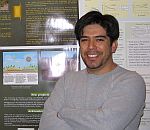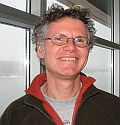
|
Engineering, Social Sciences and Hard Work: Tech Student Helps Mexican Village Clean Up its Wastewater |
| Story from Tech Today -- November 7, 2006 People in the small, desperately poor Mexican town of Rosario used to call Agustin Robles “that crazy lagoon guy.”
What caused the residents of Rosario to change their minds about Robles, then a master’s student in environmental policy at Michigan Tech, was the news that their town had finally received the money to build a new sewage treatment facility. Professor Alex Mayer, whose field engineering class designed the system, credits Robles with knitting together the social and political alliances that made it happen. The story began several years ago, when Mayer, a professor of geological and mining engineering and sciences, was in Mexico as part of an ongoing partnership between Michigan Tech and the University of Sonora. “I was asked if I could help with wastewater treatment in Rosario,” he says. “They basically had untreated wastewater going into a local creek, and the town is one of the poorest in the state of Sonora.” Mayer set a class of fledgling Peace Corps volunteers on the task, and they came up with a simple, effective design. But when the town submitted their proposal to the federal Agency for Social Development, they were turned down twice, once for bureaucratic reasons and again because officials didn’t think the community had the resources to build and maintain the system. “One of the problems was that we had little connection with the people,” Mayer says. “The federal government didn’t want to put something in and then have it fall apart.” Mexico, like many developing countries, is strewn with the wreckage of infrastructure improvements imposed on poor communities by well-intentioned outsiders. Without funding, trained personnel or community involvement, these shiny new assets can quickly tumble into wrack and ruin. Rosario’s first sewage system, built in the 1980s, had suffered such a fate; it deteriorated into a pipe feeding a lagoon that drained raw sewage into the local river (thus the genesis of Robles’s “lagoon guy” nickname). The lagoon was located in the city center, surrounded by Rosario’s poorest residents.
“I was pretty shocked and sad that people lived that way, that they had no other choice,” says Robles. “They worked to obtain money for what they were going to eat that day. Their immediate needs were so pressing, it was hard for them to focus on the environment. It was a big learning experience for me.” He passed on what he learned to local officials, who were initially skeptical that the town needed a better system. And he provided technical training on the construction and operations of the design proposed by Mayer’s class. “Agustin took it upon himself to educate the right people in the community--the local officials, the engineer--and he also had a sense of what was going on in the bureaucracy,” Mayer said. With Robles’s help, the town drafted a different proposal and requested a hearing. “I went as an external advisor, but a local engineer defended every part of the project,” says Robles. This time, Rosario got the money for its new system. The local authorities built it in little over a year with local labor and local materials. The town began pumping its sewage through the gravel-filled pit in September. “The system is called a constructed wetlands, and it’s based on how wetlands and swamps work in nature,” Mayer explains. “It requires little maintenance.” The wastewater treatment plant has become a poster child for the right way to help marginalized communities. “The project has gotten a lot of publicity in Mexico,” says Mayer. So much publicity, in fact, that a grand opening is expected to draw high-level officials from the Mexican government. “The reason people are excited is that they see this as a way to get things done.” “It’s been a unique partnership, involving us, the Mexican Social Services Agency, the community, and the University of Sonora,” says Mayer. It has also forged unusual ties within Michigan Tech. Faculty from the Department of Social Sciences, including Robles’s advisor, Professor Mary Durfee, and Associate Professor Carol Maclennan, assisted with the community survey. Robles has earned his master’s and is now pursuing a PhD in Environmental Engineering, in part because he wants to continue what he started in Rosario. “We wanted to extend the work,” he says. “And also, it’s very gratifying for me to be welcomed as one of their own.”
|
Department of Geological & Mining Engineering & Sciences
Michigan Technological University
1400 Townsend Drive - Houghton, MI 49931-1295
(906) 487-2531
 Now, when he visits, they call him Engineer Robles and he gets
more invitations to come to breakfast, lunch and dinner than he
can handle. “I couldn’t find enough time or space in
my stomach to accept them all,” he says. “My last few
weeks there were exhilarating.”
Now, when he visits, they call him Engineer Robles and he gets
more invitations to come to breakfast, lunch and dinner than he
can handle. “I couldn’t find enough time or space in
my stomach to accept them all,” he says. “My last few
weeks there were exhilarating.” With Mayer’s encouragement, Robles went to work. He interacted
with hundreds of citizens to assess local attitudes on water treatment,
the environment, and public health in general. A resident of Hermosillo,
the capital of state of Sonora, he was unprepared for the rural
poverty he witnessed.
With Mayer’s encouragement, Robles went to work. He interacted
with hundreds of citizens to assess local attitudes on water treatment,
the environment, and public health in general. A resident of Hermosillo,
the capital of state of Sonora, he was unprepared for the rural
poverty he witnessed.